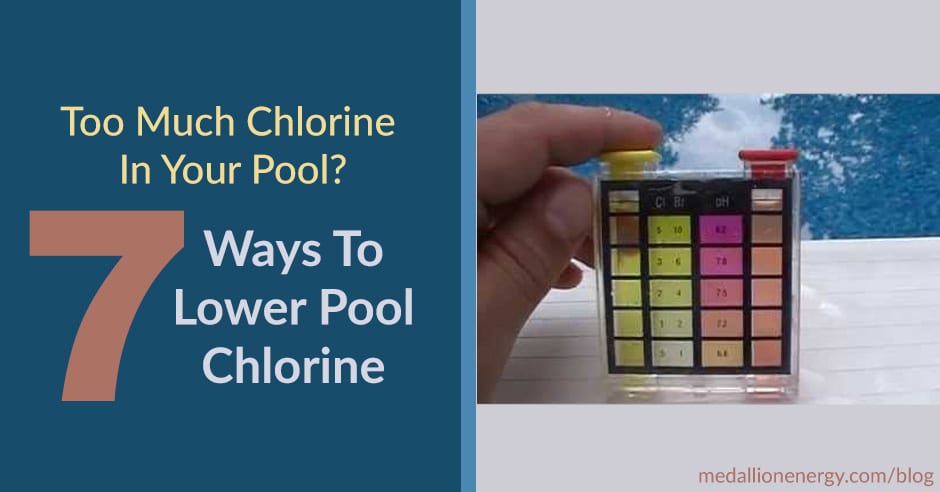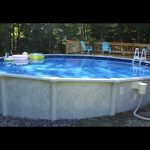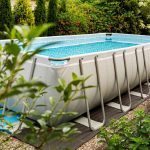Chlorine is a crucial element in maintaining the cleanliness and safety of a pool. However, excessive chlorine levels can lead to skin and eye irritation, and even affect the pool’s pH balance. Therefore, it’s essential to know how to lower the chlorine level in a pool effectively and efficiently. In this comprehensive guide, we’ll explore various methods to reduce chlorine levels and restore the perfect balance to your pool.
Test the Chlorine Level
The first step in addressing high chlorine levels in a pool is to test the water. You can use a pool water testing kit to determine the current chlorine level. This will provide you with a baseline measurement to work with and help you gauge the effectiveness of the methods you’ll use to lower the chlorine level.

Credit: www.medallionenergy.com
Dilution
One of the simplest ways to lower the chlorine level in your pool is through dilution. This involves adding fresh water to the pool to reduce the concentration of chlorine. By diluting the pool water, you effectively lower the overall chlorine level, bringing it back to a safe and comfortable range. Be sure to retest the water after dilution to ensure the chlorine level has decreased to the desired range.
Use Sodium Thiosulfate
Sodium thiosulfate, also known as chlorine neutralizer, is a popular chemical used to reduce chlorine levels in pools. It works by chemically reacting with the chlorine in the water, effectively neutralizing its concentration. When using sodium thiosulfate, it’s crucial to follow the manufacturer’s instructions carefully to ensure safe and effective application. Additionally, always wear protective gear when handling pool chemicals.
Allow for Natural Dissipation
Another method to lower chlorine levels in a pool is to simply allow for natural dissipation. By leaving the pool uncovered and allowing sunlight and air exposure, the chlorine will naturally dissipate over time. This process can be expedited by increasing the pool’s circulation and aeration, such as running the pool pump and using fountains or water features to agitate the water surface.
Use Activated Carbon
Activated carbon, commonly found in the form of granules or pellets, can be used to absorb excess chlorine from pool water. By adding activated carbon to the pool’s filtration system or placing it in a porous bag and submerging it in the water, the carbon will effectively absorb the excess chlorine, helping to lower its concentration. Regular monitoring of the chlorine level is essential when using activated carbon to ensure the desired reduction is achieved.
Balance the Pool’s pH
High chlorine levels can often be accompanied by imbalanced pH levels. To effectively lower the chlorine level, it’s important to ensure the pool’s pH is within the optimal range. You can use pH decreaser or increaser to adjust the pH level as needed, which can in turn help to stabilize and lower the chlorine concentration in the pool.

Credit: www.backyardpoolsuperstore.com
Consider Using Hydrogen Peroxide
Hydrogen peroxide can serve as an effective chlorine neutralizer in a pool. By adding hydrogen peroxide to the water, it reacts with the chlorine and helps to lower its concentration. When using hydrogen peroxide, it’s important to carefully follow dosage recommendations and allow for proper mixing and circulation within the pool water to ensure even distribution and effective neutralization of chlorine.
Regular Maintenance and Monitoring
Ultimately, preventing high chlorine levels in a pool is key to maintaining a safe and enjoyable swimming environment. Regular maintenance, including routine testing of the water’s chemical levels, can help identify and address potential issues before they escalate. By staying proactive and vigilant in pool maintenance, you can effectively manage and lower chlorine levels as needed, ensuring a comfortable and inviting pool for all to enjoy.
Conclusion
Lowering chlorine levels in a pool is an essential aspect of pool maintenance and ensures the comfort and safety of swimmers. By utilizing various methods such as dilution, using sodium thiosulfate, allowing for natural dissipation, using activated carbon, balancing the pool’s pH, and considering hydrogen peroxide, you can effectively manage and lower chlorine levels as needed. Regular maintenance and monitoring are also crucial in preventing high chlorine levels and maintaining a balanced and inviting pool environment. By following these guidelines, you can effectively lower chlorine levels in your pool and enjoy a safe and comfortable swimming experience.




